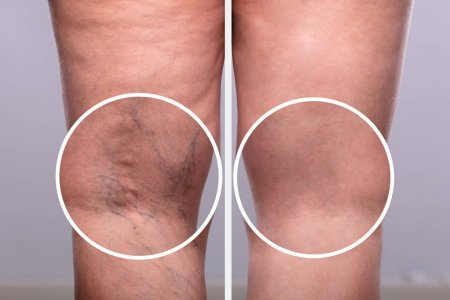Treatments for varicose veins and venous insufficiency have become less invasive over the last decade. A number of different procedures are now possible most involving local anaesthetic or requiring no anaesthetic at all. Rather than remove all the faulty veins, which was done in traditional surgery, the newer techniques aim to block or “ablate” the faulty veins. This can have the same benefit in terms of vein function, but is less invasive.
Some chemical agents when injected into veinscause them to become inflamed, and with time, scarring occurs leading to obliteration of the vein. Veins with faulty valves and varicisoites can be treated in this way. This is called sclerotherapy and has been practised for many years. Mixing the chemicals with air to make a foam is a more recent development which gives better results.
Modern ultrasound can be used to direct the foam into the correct vein also improving results. Foam sclerotherapy can be performed in a clinic and does not require any anaesthesia. Following the treatment it is important to wear a bandage and/or a support stocking on the leg for 2 weeks. Success rates are approximately 70 – 80%. If the veins do not disappear the treatment can be repeated. Side effects can be due to reactions to the foam entering the general circulation. With care these reactions are uncommon and transient. Local “phlebitis” of the treated vein (inflamed thrombosis) can cause pain for 1-2 weeks and may occasionally leave some marking on the leg.(10-15%).
Mechanico-chemical vein ablation is where the sclerosant chemical is delivered directly into the faulty saphenous vein trunk with a catheter that also physically spins and slightly damages the lining of the vein. This combination is desgined to increase the success rate for obliterating the vein. The potential advantage of this is that it is less uncomfortable and needs less local anaesthetic than the thermal techniques (see next section). The long term durability is still being evaluated for this technique.
Endothermal Ablation
EndoVenous Laser Ablation (EVLA) and Readiofrequency Ablation (RFA) are techniques for treating varicose veins. These procedures seal off the main underlying faulty vein that is feeding the varicosities. This will be either the Long saphenous Vein (LSV) in the thigh or the Short Saphenous Vein (SSV) behind the knee and calf. The traditional operation was to tie and strip these veins. These ablation techniques have replaced that surgery and are less painful with quicker recovery.
EVLA and RFA are techniques to remove the LSV and SSV from the circulation without a wound and without stripping. Both these treatments can be performed under local anaesthesia. A catheter is passed up the vein from the ankle or knee level. It is carefully placed at the junction between the LSV/SSV and the deeper veins. An ultrasound scan is used to place the catheter precisely.





